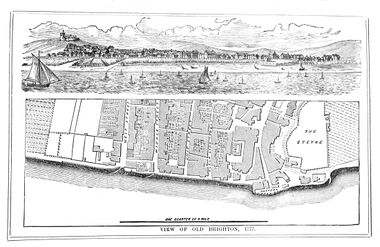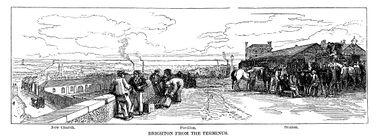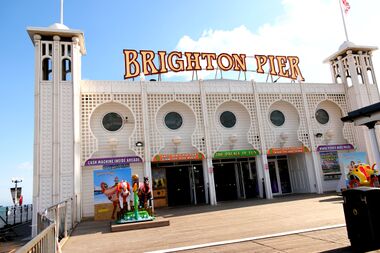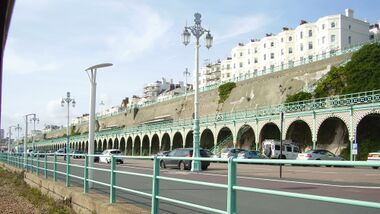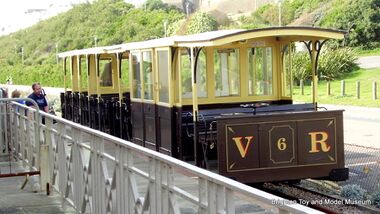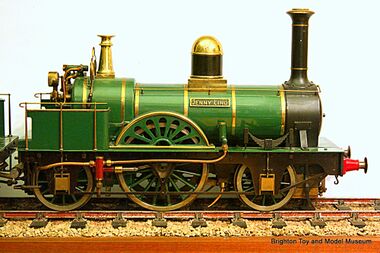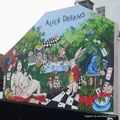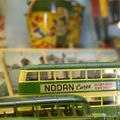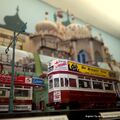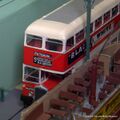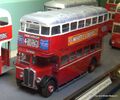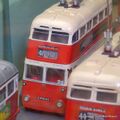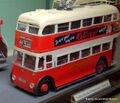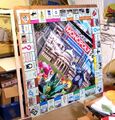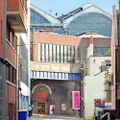Category:Brighton: Difference between revisions
(+image) |
|||
| (21 intermediate revisions by the same user not shown) | |||
| Line 1: | Line 1: | ||
{{Box|View_and_street_plan_of_Old_Brighton_in_1777_(FrAl_1888).jpg|1777: Street plan of the seaward side of Old Brighton. Note the battery gun emplacement near the Steyne, to defend against invaders|380}} | {{#SEO: |title=Brighton, East Sussex}} | ||
{{GPS}} | |||
{{Box|Brighton_By_Night,_by_HG_Gawthorn_(BrightonHbk_1935).jpg|~1935: "Brighton By Night", by H.G. Gawthorn|380}} | |||
{{Box|View_and_street_plan_of_Old_Brighton_in_1777_(FrAl_1888).jpg|1777: Street plan of the seaward side of Old Brighton. Note the battery gun emplacement near [[the Steyne]], to defend against invaders|380}} | |||
{{Box|Map_of_Brighton_in_1779_(NGB_1885).jpg|1777: Map of Brighton|380}} | {{Box|Map_of_Brighton_in_1779_(NGB_1885).jpg|1777: Map of Brighton|380}} | ||
{{Box|Brighton_Chain_Pier_unidentified_2.jpg|Brighton's original [[Chain Pier]], now gone|380}} | {{Box|Brighton_Chain_Pier_unidentified_2.jpg|Brighton's original [[Chain Pier]], now gone|380}} | ||
{{Box|Brighton_From_the_Terminus_(Railway_Chronicle_Travelling_Chart,_~1846).jpg|1846: Brighton from the Terminus|380}} | {{Box|Brighton_From_the_Terminus_(Railway_Chronicle_Travelling_Chart,_~1846).jpg|1846: Brighton from the Terminus|380}} | ||
{{Box|Aquarium_Clock_Tower,_engraving_(NGB_1885).jpg|Aquarium Clock Tower, now part of Brighton Palace Pier's frontage|380}} | {{Box|Aquarium_Clock_Tower,_engraving_(NGB_1885).jpg|Aquarium Clock Tower, now part of Brighton Palace Pier's frontage|380}} | ||
{{Box| | {{Box|Places_of_Interest_in_Brighton_(TNAB_1888).jpg|'''1888:''' Places of Interest in Brighton|380}} | ||
{{Box|Brighton_Pier_illuminated_sign_(May_2016).jpg|Brighton's famous [[Palace Pier]]|380}} | {{Box|Brighton_Pier_illuminated_sign_(May_2016).jpg|Brighton's famous [[Palace Pier]]|380}} | ||
{{Box|Brighton_Pier,_seen_from_the_Brighton_Wheel,_2014.jpg|The Palace Pier seen from above|380}} | {{Box|Brighton_Pier,_seen_from_the_Brighton_Wheel,_2014.jpg|The Palace Pier seen from above|380}} | ||
| Line 19: | Line 22: | ||
==Brighton history== | ==Brighton history== | ||
The town was originally a fishing village, and gained a population of Flemish immigrant fishermen who lived and worked under the cliffs, until a terrible storm washed away this part of the town. Above the cliffline, the village formed a compact rectangle, bounded on the North by North Street, the West by West Street, and the East by East Street, with the open region to the East – The Steyne - used by fishermen as a place to spread out and repair their nets. Repeatedly attacked by the French, the town gained a battery of guns to fend off unfriendly ships. | The town was originally a fishing village, and gained a population of Flemish immigrant fishermen who lived and worked under the cliffs, until a terrible storm washed away this part of the town. Above the cliffline, the village formed a compact rectangle, bounded on the North by North Street, the West by West Street, and the East by East Street, with the open region to the East – [[The Steyne]] - used by fishermen as a place to spread out and repair their nets. Repeatedly attacked by the French, the town gained a battery of guns to fend off unfriendly ships. | ||
Plagued by erosion and storm damage, '''Brighthelmstone''' spent much of 1600-1750 afflicted by widespread poverty and bad luck, until its fortunes started to change with the appearance of '''Dr. Richard Russell''' in the town, who wrote about the curative properties of bathing in seawater. The influx of people coming to experience the healing properties of '''Doctor Brighton''' created a fledgeling tourist industry, and in the 1780s the Prince Regent (who later became [[George IV]]) visited and decided to move in, adopting a farmhouse by the Steine, and progressively enlarging and remodelling it and its grounds until it became the current '''[[Royal Pavilion]]'''. | Plagued by erosion and storm damage, '''Brighthelmstone''' spent much of 1600-1750 afflicted by widespread poverty and bad luck, until its fortunes started to change with the appearance of '''Dr. Richard Russell''' in the town, who wrote about the curative properties of bathing in seawater. The influx of people coming to experience the healing properties of '''Doctor Brighton''' created a fledgeling tourist industry, and in the 1780s the Prince Regent (who later became [[George IV]]) visited and decided to move in, adopting a farmhouse by the Steine, and progressively enlarging and remodelling it and its grounds until it became the current '''[[Royal Pavilion]]'''. | ||
| Line 30: | Line 33: | ||
Brighton has attracted more than its fair share of new media businesses, and architects, graphic designers, product designers, photographers, game designers and other new media professionals. This has been partly because of the city's short travel time to Central London, partly because of the city's more laid-back and less "dog-eat-dog" attitude compared to London ... and partly because, unlike Soho, Brighton has a beach! The area directly to the East of the station, that used to be occupied by the Locomotive Works is now the '''New England development area''', which encourages new media businesses. | Brighton has attracted more than its fair share of new media businesses, and architects, graphic designers, product designers, photographers, game designers and other new media professionals. This has been partly because of the city's short travel time to Central London, partly because of the city's more laid-back and less "dog-eat-dog" attitude compared to London ... and partly because, unlike Soho, Brighton has a beach! The area directly to the East of the station, that used to be occupied by the Locomotive Works is now the '''New England development area''', which encourages new media businesses. | ||
Architecturally, the '''[[Brighton Wheel]]''' transformed the city's skyline for its five-year run starting in 2011, and Marks-Barfield's '''[[i360]]''' observation tower is due to open in Summer 2016. Although the i360 has been controversial, it has also enabled the regeneration of the adjacent stretch of seafront. | Architecturally, the '''[[Brighton Wheel]]''' transformed the city's skyline for its five-year run starting in 2011, and Marks-Barfield's '''[[i360]]''' observation tower is due to open in Summer 2016. Although the i360 has been controversial, it has also enabled the regeneration of the adjacent stretch of seafront. | ||
==1838 description:== | |||
{{Quotation2| | |||
<h4>THE TOWN</h4> | |||
The vicinity of Brighton to the Metropolis, and its easy and pleasant communication to that populous commercial city; the salubrity of its atmosphere, which is seldom obscured by fogs, the crystaline brightness and purity of its water, the abundant and excellent manner with which its market is supplied, the elegance and spaciousness of its houses, and the suitable accommodations they offer to individuals or to families, with the most numerous and extensive retinue of servants; all unite to render it the first watering place in the kingdom, and added to which, its being the occasional residence of the Court, gives it a decided pre-eminence over every other marine resort for the superior rank of its visitants and the splendour and fashion of its circles. Six hours is the time that is generally allowed to the stage coaches to and from London, and as the journeys are often performed much within that space, and with the greatest ease, it is | |||
scarcely necessary to observe, that those who travel in their own carriages, with suitable relay of horses, may, if they please, go over the same ground much quicker. | |||
The situation of the town is of the most romantic and agreeable description; at the bottom of an extensive bay formed by the promontories of Beachy Head to the east, and Selsey Bill to the west, it extends three miles on the sea coast, rising with a gentle ascent, east and west, from the centre of the town. Its front to the south appears to project into the bed of the ocean, the waters being kept back by means of groynes, which are well contrived, and formed of oak; and from the quantities of wild thyme, and other aromatic shrubs, that spontaneously grow on the downs, the air, particularly after a shower, is impregnated with odours the most refreshingly grateful to the senses. | |||
The Town is fifty miles distant from London, the nearest road, by Red Hill and Croydon; fifty-two by way of Reigate and Sutton; and fifty-eight by way of Horsham and Dorking; it is distant from Lewes eight miles, and from Chichester thirty miles; the living is a vicarage value £1041, in the gift of the Bishop of Chichester. | |||
The number of resident inhabitants is 40,634 according to the census of 1831, but during the fashionable season the population is estimated at 60,000. | |||
The conveniences of the place correspond with its magnitude; many of the shops are equal to those of London – the places of amusement are various and select – there is every requisite for bathing – the baths are numerous – the accommodation for visitors is excellent, and many advantages are here to be found which are wanting in smaller and less frequented watering places. | |||
|Author=Saunders|Publication=The Stranger's Guide in Brighton; Being a Complete Companion to that Fashionable Place, and the Rides and Drives in Its Vicinity.|Date=1838}} | |||
==1840 overview: The Parliamentary Gazetteer of England and Wales== | ==1840 overview: The Parliamentary Gazetteer of England and Wales== | ||
{{Quotation2| | {{Quotation2| | ||
''Town.''} – The town is situated at the bottom of a bay of the English channel, formed on the one hand by Beechy-head, and on the other by Selsea-bill. From the north and north-east winds it is sheltered by the semicircular range of the South Downs, which are easy of access, and command extensive views of the weald of Sussex and the isle of Wight. The climate of Brighton and its vicinity is warm, from its southern aspect, and the shelter afforded by the Downs from northerly and easterly winds; yet it is rendered refreshing and bracing by an almost continual sea-breeze. The town covers a considerable space of ground, presenting a sea-frontage of nearly 3 miles in extent, and consists for the most part of spacious streets, intersecting each other at right angles, lighted with gas, and well paved. The whole is divided into two nearly equal portions by an open space, extending the whole length of the valley, from the entrance from London to the sea, and varying from 50 to 100 yards in width. At the northern extremity of this opening are situated the public gardens; the next portion is termed [[the Level]], a piece of land held in trust as a cricket-ground, and for other pedestrian exercises and diversions. In 1836 the town-commissioners fenced it round with iron posts and rails, and have cleared and levelled it at very considerable expense. It is now reduced to about eight acres, two acres having been taken for the adjoining roads. Immediately south of the Level, in the centre of the open space, is St. Peter's church, a very elegant Gothic building. Beyond this are two handsome enclosures, affording a very agreeable resort for the occupiers of the houses on each side, called the North Steyne. The palace with its grounds occupies the next portion; and lastly, the Steyne | ''Town.''} – The town is situated at the bottom of a bay of the English channel, formed on the one hand by Beechy-head, and on the other by Selsea-bill. From the north and north-east winds it is sheltered by the semicircular range of the South Downs, which are easy of access, and command extensive views of the weald of Sussex and the isle of Wight. The climate of Brighton and its vicinity is warm, from its southern aspect, and the shelter afforded by the Downs from northerly and easterly winds; yet it is rendered refreshing and bracing by an almost continual sea-breeze. The town covers a considerable space of ground, presenting a sea-frontage of nearly 3 miles in extent, and consists for the most part of spacious streets, intersecting each other at right angles, lighted with gas, and well paved. The whole is divided into two nearly equal portions by an open space, extending the whole length of the valley, from the entrance from London to the sea, and varying from 50 to 100 yards in width. At the northern extremity of this opening are situated the public gardens; the next portion is termed [[the Level]], a piece of land held in trust as a cricket-ground, and for other pedestrian exercises and diversions. In 1836 the town-commissioners fenced it round with iron posts and rails, and have cleared and levelled it at very considerable expense. It is now reduced to about eight acres, two acres having been taken for the adjoining roads. Immediately south of the Level, in the centre of the open space, is St. Peter's church, a very elegant Gothic building. Beyond this are two handsome enclosures, affording a very agreeable resort for the occupiers of the houses on each side, called the North Steyne. The palace with its grounds occupies the next portion; and lastly, the Steyne brings us to the sea-side, or rather, to the York and Albion hotels, which have been permitted to intervene between the Steyne and the sea. The older part of the town is chiefly situated to the west of the Steyne, which forms a beautiful lawn, from which the east and west cliffs rise with a gentle ascent. On the northern part, called the Old Steyne, a fine statue of his majesty [[George IV]]. has been erected; it was executed by Chantrey, in bronze. On the eastern cliff are the Royal crescent, the Marine parade, Pavilion parade, and other fine ranges of buildings commanding views of the sea. Still farther to the east, is Kemp town, which consists of three sides of a quadrangle, from the extremities of which other rows of houses branch-off, enclosing spacious pleasure grounds which communicate with the beach. The sea-wall at the eastern part of Brighton is the greatest improvement ever made in this place, and affords a magnificent and unequalled promenade. On the western cliff are Cannon-place, Bedford-square, [[Regency Square|Regency-square]], and Terrace, with an extensive esplanade much resorted to as a fashionable promenade. On this point of the coast is a battery mounting six 42 pounders. [[Pavilion|The pavilion]], a palace erected by [[George IV]]., and for a long time his favourite residence, was begun in 1784; and, after many additions and alterations, finally completed in 1827, in the form of the celebrated palace of the Kremlin at Moscow. Connected with this structure are extensive pleasure-grounds, a suite of stables in the Arabian style, and a chapel-royal capable of accommodating 1,000 persons. About half-a-mile to the west of the old church is a chalybeate spring much resorted to by invalids. There are several public libraries, and a handsome theatre. The Sussex Scientific and Literary Institution was founded here in 1836. Races are held in August, on the neighbouring downs. | ||
brings us to the sea-side, or rather, to the York and Albion hotels, which have been permitted to intervene between the Steyne and the sea. The older part of the town is chiefly situated to the west of the Steyne, which forms a beautiful lawn, from which the east and west cliffs rise with a gentle ascent. On the northern part, called the Old Steyne, a fine statue of his majesty [[George IV]]. has been erected; it was executed by Chantrey, in bronze. On the eastern cliff are the Royal crescent, the Marine parade, Pavilion parade, and other fine ranges of buildings commanding views of the sea. Still farther to the east, is Kemp town, which consists of three sides of a quadrangle, from the extremities of which other rows of houses branch-off, enclosing spacious pleasure grounds which communicate with the beach. The sea-wall at the eastern part of Brighton is the greatest improvement ever made in this place, and affords a magnificent and unequalled promenade. On the western cliff are Cannon-place, Bedford-square, Regency-square, and Terrace, with an extensive esplanade much resorted to as a fashionable promenade. On this point of the coast is a battery mounting six 42 pounders. [[The pavilion]], a palace erected by [[George IV]]., and for a long time his favourite residence, was begun in 1784; and, after many additions and alterations, finally completed in 1827, in the form of the celebrated palace of the Kremlin at Moscow. Connected with this structure are extensive pleasure-grounds, a suite of stables in the Arabian style, and a chapel-royal capable of accommodating 1,000 persons. About half-a-mile to the west of the old church is a chalybeate spring much resorted to by invalids. There are several public libraries, and a handsome theatre. The Sussex Scientific and Literary | |||
''Population, Markets, &c.}'' – The pop., in 1801, was 7,339; in 1831, 40,634; but this number is greatly increased at certain seasons by the large influx of visitors. The number of houses is 7,798; of acres, within the parish, 1,980. The assessed property is rated at £71,515 of annual value. Poor rates, in 1837, £19,224. A market was established by act of parliament in 1773; Thursday is market-day. Fairs are held on Holy Thursday, and September 4th, for pedlery; but daily for provisions. There are a considerable number of boats employed in fishing, partly for the supply of the London market; the fish chiefly taken are mackerel, soles, turbot, and skate. – The town is governed by a constable and four head-boroughs. The county-magistrates hold petty sessions in the town-hall here twice a-week for the Brighton division of the rape of Lewes; and the police is regulated by commissioners appointed by the inhabitants paying scot and lot. – This borough, comprising the parishes Brighthelmstone and Hone, now returns two members to parliament. The number of electors is about 3,000, and the constable of the hundred of Whalesbone is the returning officer. | ''Population, Markets, &c.}'' – The pop., in 1801, was 7,339; in 1831, 40,634; but this number is greatly increased at certain seasons by the large influx of visitors. The number of houses is 7,798; of acres, within the parish, 1,980. The assessed property is rated at £71,515 of annual value. Poor rates, in 1837, £19,224. A market was established by act of parliament in 1773; Thursday is market-day. Fairs are held on Holy Thursday, and September 4th, for pedlery; but daily for provisions. There are a considerable number of boats employed in fishing, partly for the supply of the London market; the fish chiefly taken are mackerel, soles, turbot, and skate. – The town is governed by a constable and four head-boroughs. The county-magistrates hold petty sessions in the town-hall here twice a-week for the Brighton division of the rape of Lewes; and the police is regulated by commissioners appointed by the inhabitants paying scot and lot. – This borough, comprising the parishes Brighthelmstone and Hone, now returns two members to parliament. The number of electors is about 3,000, and the constable of the hundred of Whalesbone is the returning officer. | ||
| Line 46: | Line 62: | ||
* '''[[Brighton in the Olden Time, article (NGB 1885)]]''' – ''A history, from Nash's Guide to Brighton, 1885'' | * '''[[Brighton in the Olden Time, article (NGB 1885)]]''' – ''A history, from Nash's Guide to Brighton, 1885'' | ||
* '''[[The City Beautiful - A vision of the New Brighton (Sir Herbert Carden, 1935)]]''' – ''Brighton's future development, as seen from the perspective of 1935'' | * '''[[The City Beautiful - A vision of the New Brighton (Sir Herbert Carden, 1935)]]''' – ''Brighton's future development, as seen from the perspective of 1935'' | ||
==See also:== | ==See also:== | ||
* [[ | * [[Hove]] | ||
* [[:Category: Outside Brighton|Outside Brighton]] | |||
==Visitor guides== | ==Visitor guides== | ||
| Line 204: | Line 76: | ||
[[Category:Towns and cities]] | [[Category:Towns and cities]] | ||
{{City}} | |||
Latest revision as of 16:37, 27 February 2025
(coordinates needed)
~1935: "Brighton By Night", by H.G. Gawthorn [image info]
1777: Street plan of the seaward side of Old Brighton. Note the battery gun emplacement near the Steyne, to defend against invaders [image info]
1777: Map of Brighton [image info]
Brighton's original Chain Pier, now gone [image info]
1846: Brighton from the Terminus [image info]
Aquarium Clock Tower, now part of Brighton Palace Pier's frontage [image info]
1888: Places of Interest in Brighton [image info]
Brighton's famous Palace Pier [image info]
The Palace Pier seen from above [image info]
Brighton's Eastern Promenade, looking West [image info]
The Volks Electric Railway, the world's oldest public electric passenger railway (1883), and still going strong [image info]
The Jenny Lind: Nineteenth Century cutting-edge technology [image info]
The Pavilion Gardens North Gate [image info]
North Laine: Brighton's counterpart to London's Camden Market [image info]
2016: The headline-grabbing i360 observation tower [image info]
2016: Brighton Station Greenway approach [image info]
On England's South Coast, and one hour from London by train, East Sussex' Brighton is home to a creative hub of "new media" industries, and has been referred to as "Soho by the Sea".
The town underwent explosive growth after the arrival of a rail link to London in 1841, and has a reputation as a party town. It's currently Britain's most popular seaside location for European tourists.
Brighton history
The town was originally a fishing village, and gained a population of Flemish immigrant fishermen who lived and worked under the cliffs, until a terrible storm washed away this part of the town. Above the cliffline, the village formed a compact rectangle, bounded on the North by North Street, the West by West Street, and the East by East Street, with the open region to the East – The Steyne - used by fishermen as a place to spread out and repair their nets. Repeatedly attacked by the French, the town gained a battery of guns to fend off unfriendly ships.
Plagued by erosion and storm damage, Brighthelmstone spent much of 1600-1750 afflicted by widespread poverty and bad luck, until its fortunes started to change with the appearance of Dr. Richard Russell in the town, who wrote about the curative properties of bathing in seawater. The influx of people coming to experience the healing properties of Doctor Brighton created a fledgeling tourist industry, and in the 1780s the Prince Regent (who later became George IV) visited and decided to move in, adopting a farmhouse by the Steine, and progressively enlarging and remodelling it and its grounds until it became the current Royal Pavilion.
With a stream of people now making the trip from London to Brighton, the 1823 Chain Pier was built to provide an easy way to make the ship crossing to Dieppe, for Paris. The arrival of the London-Brighton railway line in 1841 triggered an explosive growth with Londoners now able to get to Brighton in a mere hour, and the town boomed, with large regions of the surrounding area being quickly built on. With the railway came the locomotive works, which built over 1200 steam locomotives, and the West Pier in 1866, a pleasure-palace built over the sea to cater for the whims of visiting holidaymakers. The boom encouraged Thomas Kemp to build Kemptown to the East (with the current bricked seawall and Promenade / Madeira Drive protecting his investment from falling into the sea), the Brighton Aquarium in 1872 and the Volks Electric Railway in 1883, with the town's new prosperity marked by the appearance of the Jubilee Clock Tower in 1888.
The current Palace Pier – the replacement for the old Chain Pier – opened in 1899.
Brighton in the Twenty-First Century
Brighton has attracted more than its fair share of new media businesses, and architects, graphic designers, product designers, photographers, game designers and other new media professionals. This has been partly because of the city's short travel time to Central London, partly because of the city's more laid-back and less "dog-eat-dog" attitude compared to London ... and partly because, unlike Soho, Brighton has a beach! The area directly to the East of the station, that used to be occupied by the Locomotive Works is now the New England development area, which encourages new media businesses.
Architecturally, the Brighton Wheel transformed the city's skyline for its five-year run starting in 2011, and Marks-Barfield's i360 observation tower is due to open in Summer 2016. Although the i360 has been controversial, it has also enabled the regeneration of the adjacent stretch of seafront.
1838 description:
THE TOWN
The vicinity of Brighton to the Metropolis, and its easy and pleasant communication to that populous commercial city; the salubrity of its atmosphere, which is seldom obscured by fogs, the crystaline brightness and purity of its water, the abundant and excellent manner with which its market is supplied, the elegance and spaciousness of its houses, and the suitable accommodations they offer to individuals or to families, with the most numerous and extensive retinue of servants; all unite to render it the first watering place in the kingdom, and added to which, its being the occasional residence of the Court, gives it a decided pre-eminence over every other marine resort for the superior rank of its visitants and the splendour and fashion of its circles. Six hours is the time that is generally allowed to the stage coaches to and from London, and as the journeys are often performed much within that space, and with the greatest ease, it is scarcely necessary to observe, that those who travel in their own carriages, with suitable relay of horses, may, if they please, go over the same ground much quicker.
The situation of the town is of the most romantic and agreeable description; at the bottom of an extensive bay formed by the promontories of Beachy Head to the east, and Selsey Bill to the west, it extends three miles on the sea coast, rising with a gentle ascent, east and west, from the centre of the town. Its front to the south appears to project into the bed of the ocean, the waters being kept back by means of groynes, which are well contrived, and formed of oak; and from the quantities of wild thyme, and other aromatic shrubs, that spontaneously grow on the downs, the air, particularly after a shower, is impregnated with odours the most refreshingly grateful to the senses.
The Town is fifty miles distant from London, the nearest road, by Red Hill and Croydon; fifty-two by way of Reigate and Sutton; and fifty-eight by way of Horsham and Dorking; it is distant from Lewes eight miles, and from Chichester thirty miles; the living is a vicarage value £1041, in the gift of the Bishop of Chichester.
The number of resident inhabitants is 40,634 according to the census of 1831, but during the fashionable season the population is estimated at 60,000.
The conveniences of the place correspond with its magnitude; many of the shops are equal to those of London – the places of amusement are various and select – there is every requisite for bathing – the baths are numerous – the accommodation for visitors is excellent, and many advantages are here to be found which are wanting in smaller and less frequented watering places.
— , Saunders, , The Stranger's Guide in Brighton; Being a Complete Companion to that Fashionable Place, and the Rides and Drives in Its Vicinity., , 1838
1840 overview: The Parliamentary Gazetteer of England and Wales
Town.} – The town is situated at the bottom of a bay of the English channel, formed on the one hand by Beechy-head, and on the other by Selsea-bill. From the north and north-east winds it is sheltered by the semicircular range of the South Downs, which are easy of access, and command extensive views of the weald of Sussex and the isle of Wight. The climate of Brighton and its vicinity is warm, from its southern aspect, and the shelter afforded by the Downs from northerly and easterly winds; yet it is rendered refreshing and bracing by an almost continual sea-breeze. The town covers a considerable space of ground, presenting a sea-frontage of nearly 3 miles in extent, and consists for the most part of spacious streets, intersecting each other at right angles, lighted with gas, and well paved. The whole is divided into two nearly equal portions by an open space, extending the whole length of the valley, from the entrance from London to the sea, and varying from 50 to 100 yards in width. At the northern extremity of this opening are situated the public gardens; the next portion is termed the Level, a piece of land held in trust as a cricket-ground, and for other pedestrian exercises and diversions. In 1836 the town-commissioners fenced it round with iron posts and rails, and have cleared and levelled it at very considerable expense. It is now reduced to about eight acres, two acres having been taken for the adjoining roads. Immediately south of the Level, in the centre of the open space, is St. Peter's church, a very elegant Gothic building. Beyond this are two handsome enclosures, affording a very agreeable resort for the occupiers of the houses on each side, called the North Steyne. The palace with its grounds occupies the next portion; and lastly, the Steyne brings us to the sea-side, or rather, to the York and Albion hotels, which have been permitted to intervene between the Steyne and the sea. The older part of the town is chiefly situated to the west of the Steyne, which forms a beautiful lawn, from which the east and west cliffs rise with a gentle ascent. On the northern part, called the Old Steyne, a fine statue of his majesty George IV. has been erected; it was executed by Chantrey, in bronze. On the eastern cliff are the Royal crescent, the Marine parade, Pavilion parade, and other fine ranges of buildings commanding views of the sea. Still farther to the east, is Kemp town, which consists of three sides of a quadrangle, from the extremities of which other rows of houses branch-off, enclosing spacious pleasure grounds which communicate with the beach. The sea-wall at the eastern part of Brighton is the greatest improvement ever made in this place, and affords a magnificent and unequalled promenade. On the western cliff are Cannon-place, Bedford-square, Regency-square, and Terrace, with an extensive esplanade much resorted to as a fashionable promenade. On this point of the coast is a battery mounting six 42 pounders. The pavilion, a palace erected by George IV., and for a long time his favourite residence, was begun in 1784; and, after many additions and alterations, finally completed in 1827, in the form of the celebrated palace of the Kremlin at Moscow. Connected with this structure are extensive pleasure-grounds, a suite of stables in the Arabian style, and a chapel-royal capable of accommodating 1,000 persons. About half-a-mile to the west of the old church is a chalybeate spring much resorted to by invalids. There are several public libraries, and a handsome theatre. The Sussex Scientific and Literary Institution was founded here in 1836. Races are held in August, on the neighbouring downs.
Population, Markets, &c.} – The pop., in 1801, was 7,339; in 1831, 40,634; but this number is greatly increased at certain seasons by the large influx of visitors. The number of houses is 7,798; of acres, within the parish, 1,980. The assessed property is rated at £71,515 of annual value. Poor rates, in 1837, £19,224. A market was established by act of parliament in 1773; Thursday is market-day. Fairs are held on Holy Thursday, and September 4th, for pedlery; but daily for provisions. There are a considerable number of boats employed in fishing, partly for the supply of the London market; the fish chiefly taken are mackerel, soles, turbot, and skate. – The town is governed by a constable and four head-boroughs. The county-magistrates hold petty sessions in the town-hall here twice a-week for the Brighton division of the rape of Lewes; and the police is regulated by commissioners appointed by the inhabitants paying scot and lot. – This borough, comprising the parishes Brighthelmstone and Hone, now returns two members to parliament. The number of electors is about 3,000, and the constable of the hundred of Whalesbone is the returning officer.
... Within the period of accurate history ... it was a mere fishing village, which, having been often plundered by the French, was at length fortified with walls and batteries. From this place Charles II. embarked France after the battle of Worcester. The sea often made considerable inroads here, especially in 1665, and 1705. The town was brought into repute in the reign of George II., when Dr Richard Russel recommended the use of sea-bathing for various disorders. His late majesty George IV., displayed strong partiality for it.
— , -, , The Parliamentary Gazetteer of England and Wales, p276, , A.Fullerton & Co., , 1840
Brighton's Pasts and Futures
- Brighton in the Olden Time, article (NGB 1885) – A history, from Nash's Guide to Brighton, 1885
- The City Beautiful - A vision of the New Brighton (Sir Herbert Carden, 1935) – Brighton's future development, as seen from the perspective of 1935
See also:
Visitor guides
- Visit Brighton (visitbrighton.com)
- TimeOut: 20 great things to do in Brighton (timeout.com)
- Daily Telegraph Travel: Brighton: readers' tips, recommendations and travel advice (telegraph.co.uk)
- TripAdvisor:, Brighton (tripadvisor.co.uk)
- TheGuardian Travel: Brighton (theguardian.com)
- Brighton Tourist (brightontourist.com)
Subcategories
This category has the following 187 subcategories, out of 187 total.
1
- 100 Years of Southdown (display) (11 P, 13 F)
A
- Alice Dreams, Brighton (3 F)
- Aquarium Station (9 F)
- Artists Open Houses (3 F)
- Astoria Theatre (2 F)
- Attree Villa (2 P)
B
- Black Rock Pool (5 F)
- Black Rock Station (4 F)
- Blakers Park (1 P)
- Boer War Memorial (4 F)
- Booth Museum (3 F)
- Brighton Belle Mural (6 F)
- Brighton Buses and Trams, display (Ken Allbon) (15 P, 32 F)
- Brighton Dome (1 P, 6 F)
- Brighton Fishing Museum (1 F)
- Brighton Greenway (1 P, 8 F)
- Brighton Modelworld (3 P, 10 F)
- Brighton Monopoly (3 P, 7 F)
- Brighton Palace Pier (4 P, 32 F)
- Brighton postcards (37 F)
- Brighton Pride (4 F)
- Brighton Racecourse (3 F)
- Brighton Speed Trials (1 P, 12 F)
- Brighton Station Cab Road (13 F)
- Brighton trams (6 P, 18 F)
- Brighton trolleybuses (15 P, 19 F)
- Brighton Wheel (7 F)
- Brighton Zip (4 F)
C
- Choccywoccydoodah (3 F)
- Clapshaw and Cleave (1 F)
D
E
- E. Burrows (3 P, 3 F)
- Egremont Gate, Queens Park (empty)
- Embassy Court (1 P, 5 F)
F
- Fabrica (3 F)
- Brighton Festival (11 F)
- Brighton Fringe (1 P, 12 F)
- Brighton Science Festival (4 F)
G
- Games Workshop (6 F)
- Gamleys (2 P, 1 F)
H
- Halfway Station (5 F)
- HCVS London-Brighton Run (20 F)
- Hove Lagoon (1 P, 4 F)
- Hove Lawns (2 F)
- Hove Museum and Art Gallery (2 F)
- Hove Park Miniature Railway (1 P, 17 F)
- Hove Station (8 F)
I
- I360 (18 F)
- India Gate (3 F)
- Isetta bubble-cars (6 P, 1 F)
J
- Johnstones Midget Coaches (1 P, 2 F)
- Jubilee Clock Tower (5 F)
K
- Kemp Town (3 P, 13 F)
- King Alfred Leisure Centre (2 F)
L
- Latest (3 F)
- London Road Viaduct (5 F)
- London to Brighton Rally (display) (7 P, 17 F)
M
- Madeira Lift (4 F)
N
- North Gate, Pavilion Gardens (3 F)
- North Laine Runner (7 F)
O
- Ouse Valley Viaduct (1 P, 6 F)
P
- Park Gate, Queens Park (4 F)
- Preston Park Clock Tower (3 F)
- Preston Park Pullman Works (1 P, 4 F)
- Prince Albert Mural (Brighton 2013) (1 P, 5 F)
- Prince Albert Mural (Brighton 2017) (1 P, 5 F)
- Pugets Cottage (5 F)
Q
- Queens Park Clock Tower (1 F)
R
- Regency Town House (3 F)
- Rose Gardens (6 F)
- Rotunda Cafe (5 F)
- Royal Spa (1 P)
S
- Saltdean Lido (4 F)
- Schools-Class locomotives (5 P, 10 F)
- Sea Life Brighton (empty)
- Shelter Hall (5 F)
- Snoopers Paradise (1 P, 2 F)
- Snowdogs by the Sea (4 F)
- SS Brighton (4 F)
- St Anns Well Gardens (12 F)
- St Paul's Church, Brighton (8 F)
T
- Terrier Class locomotives (2 F)
- The Argus (19 F)
- The Level (11 F)
- The Old Market (5 F)
- The Rockery, Preston Park (4 F)
- The Warren (6 F)
- Theatre Royal (3 F)
- Thos. Mayers (1 P)
- Timpsons, at 15 North Street (3 F)
- Brighton Town Hall (3 F)
- Toys R Us (5 F)
- Trafalgar Arches Market (5 F)
- Trafalgar Street Regeneration Project (1 P, 8 F)
U
- Undercliff Walk (empty)
- Union Street Chapel (3 F)
V
- Victoria Fountain (6 F)
- Victoria Gardens (6 F)
- Visitor Information Centre (3 F)
W
- Walled Gardens (6 F)
- Water Garden (3 F)
- West Pier (2 P, 24 F)
Pages in category ‘Brighton’
The following 170 pages are in this category, out of 170 total.
A
B
- Beachy Head locomotive (gauge 0)
- Bedford Duple OB Coach, 1:24 scale, Southdown JCD 371 (Original Classics)
- Bedford OB coach JCD 370 (Corgi Original Omnibus 42607)
- Belle Vue Field
- Bessemer locomotive LBSC 213 (gauge 0)
- Billington E2 tank locomotive 104 (Hornby R353)
- Blabers Foundry
- Blue Funnel, Merchant Navy Class locomotive, Southern 21C13 (Wrenn Railways W2278)
- BMW Isetta bubble-car, bright red, LTR 145 (Spot-On 118)
- BMW Isetta bubble-car, dark blue, JPO 113 (Spot-On 118)
- BMW Isetta bubble-car, dark red, LXQ 216 (Spot-On 118)
- BMW Isetta bubble-car, green, JPO 113 (Spot-On 118)
- BMW Isetta bubble-car, light mauve (Spot-On 118)
- BMW Isetta bubble-car, yellow, CMO 118 (Spot-On 118)
- Board square, Brighton Toy and Model Museum (Brighton Monopoly)
- Brighton and Rottingdean Seashore Electric Railway, poster
- Brighton and Shoreham Tramways open-topped horsedrawn tram (scratchbuilt, Ken Allbon)
- Brighton Bandstand
- Brighton clubs
- Brighton Corporation Tramways Class B open-topped tram, "E" No8 (scratchbuilt, Ken Allbon)
- Brighton Corporation Tramways Class F tram No52 (scratchbuilt, Ken Allbon)
- Brighton District Tramways, Falcon trailer tram, No2 (scratchbuilt, Ken Allbon)
- Brighton Dolphinarium
- Brighton Film Studios
- Brighton glass bottle (Hooper Struve)
- Brighton history resources
- Brighton Hove and District AEC-Tilling petrol STL-type No4 double decker bus (scratchbuilt, Ken Allbon)
- Brighton Hove and District AEC/Tilling ST Type petrol bus No.1 (scratchbuilt, Ken Allbon)
- Brighton Hove and District K6B Bristol/E.C.W. No.5 double-decker bus (scratchbuilt, Ken Allbon)
- Brighton in the Olden Time, article (NGB 1885)
- Brighton Lego Store
- Brighton locomotive 915 (ACE Trains)
- Brighton locomotives
- Brighton Motor Museum
- Brighton Pavilion (Ted Bayley model)
- Brighton Pavilion ... reflected glory (photograph, Roger Bamber)
- Brighton Pier in the snow (photograph, Roger Bamber)
- Brighton Pier with crashing waves (photograph, Roger Bamber)
- Brighton Promenade, backdrop (Lawrence Watts)
- Brighton Seafront (engraving, 1892)
- Brighton Station cast-iron roundel
- Brighton Station Goods Yard
- Brighton Station, Trafalgar Street entrances
- Brighton Toy Shops
- Brighton Tram model (Rex Morrison)
- Brighton West Pier, 2003 (photograph, Roger Bamber)
- Brighton Works, described by R J Billinton (TRM 1903)
- Brighton Zoo
- Brighton's Electric Railway, article (RWW 1935)
- Brighton, Hove and District AEC/Weymann No41 trolleybus (scratchbuilt, Ken Allbon)
- Brighton, Hove and District BUT/Weymann No44 trolleybus 391 (scratchbuilt, Ken Allbon)
- Budleigh Salterton locomotive nameplate
C
D
E
G
H
- Harrington Cavalier Coach, Southdown, 1-76 (Exclusive First Editions 12101)
- Harrington Cavalier Coach, Southdown, 1-76 (Exclusive First Editions 12304)
- Harringtons Coachbuilders
- Hollingbury Park
- Hove Barrow
- Hove Corporation Cedes Stoll-Dodson trolleybus, 1914 trial (scratchbuilt, Ken Allbon)
- Hove Lagoon Model Yacht Club
L
- Lamport and Holt Line, Merchant Navy Class locomotive, BR 35026 (Wrenn Railways W2267)
- Leader-class steam locomotive prototype, live steam, gauge 1 (Carl Wedkin-Snaith)
- Leyland PD3 Queen Mary double-decker No31 bus, Southdown BUF 272C (Corgi Original Omnibus)
- Leyland Royal Tiger coach, Southdown LUF640 (Oxford Diecast 76LRT002)
- Leyland Titan Southdown double-decker No.4 bus UF6473, Robin Starch (Matchbox MYY)
- Leyland Wayman Fanfare coach, Southdown XUF 141 (Oxford Diecast 76WFL001)
- Locomotive GWR 2253, 0-6-0, 5-inch gauge, steam (John Cashmore)
- Locomotive plate (LBSCR No.85 1912)
- London Road (Brighton) Station
- London to Brighton Electric Vehicle Rally
- LSA Models
M
- Marwood Coffee Shop
- MCW Single-decker bus, Southdown LUF 500 (Corgi Toys)
- Mechanical Memories Museum
- Merchant Taylors Schools-Class loco SR 910 (Märklin for Bassett-Lowke)
- ModelZone
- Monopoly, Brighton and Hove Edition
- Monument to John Frederick Ginnett (horse statue)
- Morris J-type commercial van RVF324, Southdown (Corgi Toys)
- Mutoscope
P
R
S
- Sevenoaks locomotive nameplate
- Shoreham branchline railway terminus
- Template:Snoopers
- South Gate
- Southdown Bus pedal car, LUF 634 Leyland Royal Tiger coach (unknown maker)
- Southdown Buses dormy shed, Amberley (Brian Bennett)
- Southdown double-decker bus GUF 144, Guy (Corgi Original Omnibus)
- Star Foundry
- Steam packet
- Stephenson locomotive (cast paperweight)
- Stephenson Tank Locomotive SR 329, gauge 0 (Märklin TK1020)
- Stephenson Tank Locomotive SR 329, gauge 1 (Märklin TK1021)
- Sussex Vintage Model Railway Collectors (SVMRC)
T
- Terminus Hotel
- Thats Nice Maxie (Max Miller 1961)
- The Boiler Shop (painting)
- The Career of Magnus Volk (1851-1937)
- The Cheeky Chappie, Max Miller (statue)
- The City Beautiful - A vision of the New Brighton (Sir Herbert Carden, 1935)
- The Dance Space
- The Erecting Shop (painting)
- The Foundry (painting)
- The Ghost of Jenny Lind (sculpture)
- The Kissing Bridge (statue)
- The National Museum of Penny Slot Machines
- The Old Penny Palace
- The Open Market
- The Station under the Station, Portrait of Chris Littledale (RogerBamber)
- The Temple
- Things to do in Brighton, for kids
- Thomas the Tank Engine locomotive (Hornby R351)
- Thomas Tilling petrol-electric bus, early (scratchbuilt, Ken Allbon)
- Thomas Tilling petrol-electric bus, later (scratchbuilt, Ken Allbon)
- Tile House, Preston Park
- Tilling Electrobus, Kemp Town No3 (scratchbuilt, Ken Allbon)
- Brighton Timeline
- Trafalgar Street regeneration project (PressRelease 2021-07)
- Trafalgar Street Traders
Media in category ‘Brighton’
The following 200 files are in this category, out of 864 total.
(previous page) (next page)- 'Kissing Policemen' mural, by Banksy, Brighton.jpg 1,200 × 1,600; 1.1 MB
- 100 Years of Southdown, Brighton Toy and Model Museum.jpg 1,200 × 800; 148 KB
- 15 North Street, Brighton (Google Streetview 2015-04).jpg 1,280 × 882; 303 KB
- 15 North Street, Brighton (Google Streetview 2017-07).jpg 1,280 × 882; 230 KB
- 1823 - The Chain Pier, showing original entrance (TBCPIM 1896).jpg 3,000 × 1,859; 3.21 MB
- 1824 - An Early Drawing of the Chain Pier (TBCPIM 1896).jpg 3,000 × 1,897; 2.06 MB
- 1824 - The Great Birthday Storm, Chain Pier (TBCPIM 1896).jpg 3,000 × 1,524; 2 MB
- 1833 - The Storm of October 15th, Chain Pier (TBCPIM 1896).jpg 3,000 × 2,005; 2.56 MB
- 1836 - The Chain Pier after the Hurricane of 29th November (TBCPIM 1896).jpg 3,000 × 1,688; 2.7 MB
- 1871 - The Chain Pier after the Removal of the Esplanade (TBCPIM 1896).jpg 3,000 × 1,670; 1.92 MB
- 1896 - The Chain Pier on its Last Legs (TBCPIM 1896).jpg 3,000 × 2,004; 2.47 MB
- 1896 - The Morning after the Storm, Chain Pier (TBCPIM 1896).jpg 3,000 × 1,921; 2.49 MB
- 1896 Chain Pier - Closed, Edward Fogden (TBCPIM 1896).jpg 1,024 × 903; 545 KB
- 1902 Panhard-Levassor, RAC London-Brighton Veteran Car Rally (2016-11).jpg 3,000 × 1,799; 1.87 MB
- 1904 De Dion-Bouton, 1903 Mercedes ×2, RAC Veteran Car Run (2016-11-06).jpg 1,200 × 675; 385 KB
- A Corner of the Lagoon (HoveIG 1936).jpg 2,500 × 1,727; 2.93 MB
- A Portrait of Brighton in Tram Days, by A G Elliot, ISBN 0951124102.jpg 857 × 1,200; 275 KB
- A Railway on Stilts 01, Brighton Rottingdean Seashore Electric Railway (RWW 1935).jpg 2,500 × 1,574; 2.88 MB
- A Railway on Stilts 02, Brighton Rottingdean Seashore Electric Railway (RWW 1935).jpg 2,500 × 1,684; 2.86 MB
- A Vision of the New Brighton, C J Launder.jpg 3,500 × 2,994; 3.33 MB
- AA Sign, Crawley, Britains Farm 579 (BritCat 1940).jpg 662 × 1,159; 64 KB
- Accessway, Preston Park Loco Works (Brighton 2018).jpg 1,600 × 1,067; 1,016 KB
- Albion Truck, HCVS Rally (Brighton 2019-05).jpg 3,000 × 1,681; 3.31 MB
- Alice Dreams Mural (Brighton 2014).jpg 2,000 × 1,428; 1.43 MB
- Alice Dreams Mural, Sara Abbott (Brighton 2012).jpg 1,196 × 1,194; 578 KB
- Alice Dreams Mural, Sara Abbott.jpg 701 × 700; 221 KB
- Alice Dreams shop, Middle Street (Brighton 2012).jpg 1,154 × 1,536; 633 KB
- Alice Dreams shop, Middle Street.jpg 1,200 × 900; 373 KB
- Another view of the Paint Shop, Brighton Works (TRM 1903-04).jpg 3,000 × 2,146; 1.36 MB
- Anthony Dowsett, Community Rail Partnership (LatestTV 2018-03-21).jpg 960 × 541; 203 KB
- Aquarium and Seafront (BrightonHbk 1935).jpg 3,897 × 2,077; 5.18 MB
- Aquarium Clock demolition, ~1927 (RoyalJubileeSP 1935).jpg 1,544 × 2,500; 626 KB
- Aquarium Clock Tower, engraving (NGB 1885).jpg 2,200 × 1,758; 902 KB
- Aquarium Station, Volks Electric Railway (RWW 1935).jpg 2,200 × 977; 1.5 MB
- Aquarium, engraving (TNAB 1888).jpg 3,000 × 1,853; 1.39 MB
- Area 81.jpg 1,200 × 1,199; 708 KB
- Area 83.jpg 2,000 × 1,998; 1.66 MB
- Argus Brighton Pride cover (Argus 2018-08-04).jpg 1,513 × 1,800; 1.71 MB
- Artists Open Houses (AOH 2019).jpg 1,399 × 2,000; 538 KB
- Artists Open Houses (AOH 2021).jpg 1,417 × 2,000; 621 KB
- Arundel Terrace, Kemp Town, postcard (Wardells).jpg 3,000 × 1,936; 1.68 MB
- Astoria Cinema (Brighton 2014).jpg 1,600 × 901; 789 KB
- Astoria Cinema, entrance (Brighton 2014).jpg 3,000 × 2,000; 3.45 MB
- BA-i360, Brighton (2016-08-04).jpg 3,264 × 2,176; 1.7 MB
- Balcombe Viaduct (Ouse Valley Viaduct), Lego Digital Designer.jpg 995 × 560; 99 KB
- Bandstand and Embassy Court, Brighton.jpg 3,000 × 2,000; 708 KB
- Bassett-Lowke, Merchant Taylors 910, gauge 0 (BL-MR 1937-11).jpg 1,526 × 2,226; 610 KB
- Belgravia, LBSCR 201, 2-4-0 locomotive (TRM 1903-04).jpg 3,000 × 1,534; 937 KB
- Big Arm ride, Brighton Pier (May 2016).jpg 1,467 × 2,200; 293 KB
- Billinton E2 0-6-0 tank locomotive, Lego Digital Designer.jpg 598 × 449; 67 KB
- Black Lion Pub, The Lanes (Brighton 2018).jpg 1,600 × 1,595; 1.45 MB
- Black Rock (BHAD10ed 1933).jpg 2,200 × 1,453; 1.66 MB
- Black Rock Pool (BHOG ~1961).jpg 3,000 × 2,667; 5.01 MB
- Black Rock Pool (BrightonHbk 1939).jpg 1,200 × 821; 890 KB
- Black Rock Pool Looking West, postcard (Excel 94).jpg 2,400 × 1,558; 1.84 MB
- Black Rock Pool, diving board (BrightonHbk 1939).jpg 1,200 × 809; 877 KB
- Black Rock Station and Marina (Brighton 2014).jpg 2,000 × 1,144; 1.59 MB
- Black Rock terminus, Volks Electric Railway.jpg 1,200 × 900; 948 KB
- Blind Peoples Gardens, Preston Park (BHOG ~1961).jpg 1,889 × 1,829; 1.99 MB
- Boating Lake and bridge, The Level (BrightonHbk 1935).jpg 2,311 × 3,000; 6.42 MB
- Boer War Peace Day, military salute, Brighton (MezzotintSeries 1902-06-02).jpg 3,000 × 1,776; 4.6 MB
- Boiler Shop, Brighton Works (TRM 1903-04).jpg 3,000 × 2,007; 1.44 MB
- Booth Museum leaflet (RPM 2018).jpg 2,067 × 2,200; 2.55 MB
- Bowls (BHOG ~1961).jpg 2,200 × 1,688; 1.43 MB
- Box back, Monopoly, Brighton and Hove Edition.jpg 1,200 × 824; 690 KB
- Bridge and waterspout (TheLevel 2013-09-23).jpg 2,000 × 1,500; 1.85 MB
- Brighton 915 Schools-Class loco (ACE Trains).jpg 800 × 600; 285 KB
- Brighton Academy of TV, BATV, Latest (AOH 2019).jpg 1,600 × 1,172; 305 KB
- Brighton and Hove Motor Club 1929 events (MotorSport 1929-05).jpg 2,260 × 1,766; 580 KB
- Brighton and Hove Pride, cover (2018).jpg 1,409 × 2,000; 1.07 MB
- Brighton and Rottingdean Seashore Electric Railway poster.jpg 814 × 1,200; 436 KB
- Brighton and Shoreham Tramways open-topped horsedrawn tram (Ken Allbon).jpg 2,000 × 788; 979 KB
- Brighton and Shoreham Tramways open-topped horsedrawn tram, end view (Ken Allbon).jpg 1,600 × 2,400; 1.74 MB
- Brighton Angel of Peace statue at sunset.jpg 3,000 × 1,980; 328 KB
- Brighton Aquarium, postcard (HM ~1903).jpg 3,000 × 1,986; 4.85 MB
- Brighton Aquarium, postcard (TucksSilverette ~1905).jpg 3,000 × 1,980; 5.02 MB
- Brighton Area Transport Services 1962-63 bus timetable, cover.jpg 1,050 × 1,600; 214 KB
- Brighton Beach from Palace Pier, postcard (Avery 1010).jpg 3,000 × 1,914; 3.46 MB
- Brighton Belle Mural, early sketch.jpg 1,173 × 683; 126 KB
- Brighton Belle Mural, partial.jpg 1,620 × 2,160; 2.07 MB
- Brighton Bus map, title page (BATS 1962-63).jpg 1,087 × 1,600; 164 KB
- Brighton Bus services (BrightonHbk 1939).jpg 2,319 × 3,000; 5.84 MB
- Brighton Bus Services map (BATS 1962-63).jpg 3,000 × 2,143; 981 KB
- Brighton Buses coordination, 1961 (BATS 1962-63).jpg 1,048 × 1,600; 318 KB
- Brighton By Night, by HG Gawthorn (BrightonHbk 1935).jpg 2,200 × 1,502; 2.44 MB
- Brighton Chain Pier unidentified 2.jpg 600 × 450; 43 KB
- Brighton Chain Pier unidentified.jpg 2,048 × 1,536; 804 KB
- Brighton Chain Pier wrecked 1896, postcard, Clem Lambert (SDNS).jpg 2,000 × 1,248; 1.9 MB
- Brighton Corporation K6B Bristol-ECW diesel bus, angle (Ken Allbon).jpg 1,200 × 1,200; 410 KB
- Brighton Corporation K6B Bristol-ECW diesel bus, side (Ken Allbon).jpg 2,200 × 1,237; 1.25 MB
- Brighton Corporation Tramways Class F tram No52 (Ken Allbon).jpg 2,600 × 1,734; 2.36 MB
- Brighton Corporation Tramways Class F tram No52, angled view (Ken Allbon).jpg 2,600 × 1,734; 2.13 MB
- Brighton Corporation Type B Tram, E No8, angle (Ken Allbon).jpg 2,000 × 1,647; 1.68 MB
- Brighton Corporation Type B Tram, E No8, side (Ken Allbon).jpg 2,000 × 1,336; 944 KB
- Brighton District Tramways, Falcon trailer tram, No2 (Ken Allbon).jpg 2,000 × 1,125; 1.15 MB
- Brighton District Tramways, Falcon trailer tram, No2, end detail (Ken Allbon).jpg 1,049 × 1,400; 416 KB
- Brighton Dome programme (2017).jpg 2,200 × 1,549; 1.4 MB
- Brighton Dome, exterior (BrightonHbk 1939).jpg 2,500 × 1,707; 1.59 MB
- Brighton Dome, interior (BrightonHbk 1939).jpg 2,500 × 1,585; 3.07 MB
- Brighton Dome, Pavilion Park (Brighton 2018).jpg 3,000 × 1,218; 2.46 MB
- Brighton Electric Trams, postcard, Victoria Gardens.jpg 3,000 × 1,936; 3.59 MB
- Brighton Festival (2020).jpg 1,800 × 1,284; 633 KB
- Brighton Festival (2024).jpg 2,000 × 1,436; 672 KB
- Brighton Festival (MapAd 2021).jpg 1,159 × 1,800; 605 KB
- Brighton Festival Bus (EFE 14001).jpg 1,600 × 783; 172 KB
- Brighton Festival Childrens Parade, Trafalgar Street (2016-05-07).jpg 2,000 × 3,000; 2.76 MB
- Brighton Festival street art (2021).jpg 3,000 × 2,000; 897 KB
- Brighton Festival, full cover (BrFestival 2018).jpg 2,000 × 1,437; 375 KB
- Brighton Fishing Museum panorama (~2012).jpg 1,600 × 400; 140 KB
- Brighton Fringe Box Office (Brighton 2019-04-024).jpg 2,200 × 1,467; 991 KB
- Brighton Fringe Events 2018.jpg 2,000 × 1,414; 745 KB
- Brighton Fringe logo (2019).jpg 335 × 184; 23 KB
- Brighton Fringe mural, Middle Street (2015-07).jpg 2,000 × 1,497; 1.62 MB
- Brighton Fringe, venue board, Venue 195, BTMM (2016-05).jpg 1,564 × 2,000; 1.66 MB
- Brighton From the Terminus (Railway Chronicle Travelling Chart, ~1846).jpg 4,494 × 1,650; 1.79 MB
- Brighton Greenway approach, seating and Brighton Station (June 2016).jpg 2,000 × 1,334; 669 KB
- Brighton Greenway approach, station end (June 2016).jpg 3,000 × 2,000; 3.64 MB
- Brighton Greenway, April 2016.jpg 2,000 × 1,334; 1.89 MB
- Brighton Hippodrome roughmodel view 01 (BIn3D 2018).jpg 3,000 × 1,314; 442 KB
- Brighton Hippodrome roughmodel view 02 (BIn3D 2018).jpg 3,000 × 1,314; 674 KB
- Brighton Hippodrome roughmodel view 03 (BIn3D 2018).jpg 1,597 × 912; 388 KB
- Brighton Hippodrome roughmodel view 04 (BIn3D 2018).jpg 3,000 × 1,713; 947 KB
- Brighton Hove and District AEC-Tilling petrol STL-Type No4 bus, angled (Ken Allbon).jpg 1,600 × 1,330; 708 KB
- Brighton Hove and District AEC-Tilling petrol STL-Type No4 bus, side (Ken Allbon).jpg 2,000 × 1,125; 929 KB
- Brighton Hove and District AEC-Weymann No41 trolleybus, angle (Ken Allbon).jpg 1,200 × 1,200; 416 KB
- Brighton Hove and District AEC-Weymann No41 trolleybus, side (Ken Allbon).jpg 2,000 × 1,124; 904 KB
- Brighton Hove and District BUT-Weymann No44 trolleybus 391, angled (Ken Allbon).jpg 1,600 × 1,379; 804 KB
- Brighton Information Centre, leaflet, bothsides (~2013).jpg 1,129 × 1,200; 1.11 MB
- Brighton locomotive SR 915 (RWW 1935).jpg 2,200 × 781; 1.26 MB
- Brighton Map (VisitBrighton 2008).jpg 1,398 × 3,000; 2.98 MB
- Brighton Map (VisitBrighton 2011).jpg 1,417 × 3,000; 4.04 MB
- Brighton Map (VisitBrighton 2012).jpg 1,425 × 3,000; 3.6 MB
- Brighton Map (VisitBrighton 2013).jpg 1,409 × 3,000; 2.91 MB
- Brighton Map (VisitBrighton 2014).jpg 1,432 × 3,000; 2.69 MB
- Brighton Map (VisitBrighton 2016).jpg 1,417 × 3,000; 3.05 MB
- Brighton Map (VisitBrighton 2017).jpg 1,418 × 3,000; 2.79 MB
- Brighton Map (VisitBrighton Int2008).jpg 1,400 × 3,000; 2.77 MB
- Brighton Map, cropped (Crutchleys 1860).jpg 2,669 × 1,231; 1.98 MB
- Brighton Map, cropped, Shoreham to Rottingdean (Crutchleys 1860).jpg 3,000 × 1,155; 2.29 MB
- Brighton Marina (i360view 2018).jpg 3,000 × 2,000; 3.73 MB
- Brighton Marina, leaflet, side1 (2018).jpg 3,000 × 2,110; 5.11 MB
- Brighton Marina, leaflet, side2 (2018).jpg 3,000 × 2,116; 4.41 MB
- Brighton ModelWorld 2012 guide, cover.jpg 2,330 × 2,500; 3.98 MB
- Brighton ModelWorld 2015 guide, cover.jpg 2,374 × 2,500; 4.28 MB
- Brighton Monopoly board, publicity backdrop (2017-11-10).jpg 3,000 × 2,000; 4.49 MB
- Brighton Monopoly board, publicity backdrop, awaiting storage (2017-11-10).jpg 1,151 × 1,200; 1.09 MB
- Brighton Monopoly, boxes.jpg 2,000 × 1,334; 1.99 MB
- Brighton Motor Museum (Montagu 1961).jpg 1,229 × 1,600; 1.18 MB
- Brighton Motor Trials, July 1905, postcard (Mezzotint).jpg 3,000 × 1,941; 3.69 MB
- Brighton Motor Trials, July 1905, postcard detail (Mezzotint).jpg 1,244 × 697; 671 KB
- Brighton Museum and Art Gallery, 2011.jpg 1,650 × 2,200; 1.37 MB
- Brighton Museum and Art Gallery, corner view, 2011.jpg 2,200 × 1,650; 1.38 MB
- Brighton Palace Pier (2021-08).jpg 3,000 × 2,000; 1.33 MB
- Brighton Pavilion (stained glass at Brighton Palace Pier).jpg 1,600 × 1,600; 288 KB
- Brighton Pavilion 043, 2011.jpg 1,650 × 2,200; 1.29 MB
- Brighton Pavilion 048, 2011.jpg 2,200 × 1,650; 1.4 MB
- Brighton Pavilion Grand Entrance, engraving (NGB 1885).jpg 2,200 × 1,467; 878 KB
- Brighton Pavilion in 1788 (NGB 1885).jpg 2,200 × 1,462; 635 KB
- Brighton Pavilion, Ted Bayley, detail.jpg 1,600 × 1,200; 1,010 KB
- Brighton Pier illuminated sign (May 2016).jpg 2,200 × 1,467; 550 KB
- Brighton Pier screen (May 2016).jpg 2,200 × 1,467; 749 KB
- Brighton Pier sign, detail (May 2016).jpg 2,200 × 1,467; 392 KB
- Brighton Pier, seen from the Brighton Wheel, 2014.jpg 2,400 × 1,351; 1.7 MB
- Brighton Pride Festival 2018, page (FridayAd 2018-08-03).jpg 940 × 1,200; 499 KB
- Brighton Promenade arch, exterior.jpg 1,200 × 900; 703 KB
- Brighton Promenade arch, interior.jpg 1,200 × 900; 639 KB
- Brighton Promenade backdrop, Lawrence Watts.jpg 1,600 × 1,200; 1.01 MB
- Brighton Promenade, cliffside.jpg 1,200 × 673; 576 KB
- Brighton Promenade, enigmatic doorway.jpg 1,200 × 900; 654 KB
- Brighton Promenade, looking West, 2011.jpg 2,000 × 1,127; 1.84 MB
- Brighton Racecourse (BHOG ~1961).jpg 1,200 × 999; 876 KB
- Brighton Racecourse (BrightonHbk 1935).jpg 1,594 × 1,797; 1.95 MB
- Brighton Railway Station building, clock.jpg 2,200 × 1,467; 1.73 MB
- Brighton Science Festival, poster (BSF 2015).jpg 609 × 857; 220 KB
- Brighton Science Festival, poster (BSF 2016).jpg 605 × 857; 146 KB
- Brighton Science Festival, poster (BSF 2018).jpg 806 × 1,151; 185 KB
- Brighton seafront attractions (Brighton 2018).jpg 3,000 × 1,814; 3.06 MB
- Brighton Shopping Centre, All Change For (1980).jpg 1,222 × 980; 216 KB
- Brighton Sports Arena, Withdean (BHOG ~1961).jpg 1,800 × 1,152; 986 KB
- Brighton Station (stained glass at Brighton Palace Pier).jpg 1,600 × 1,600; 219 KB
- Brighton Station approach (Brighton Greenway, April 2016).jpg 2,500 × 1,667; 2.93 MB
- Brighton Station enamelled sign.jpg 3,000 × 1,001; 446 KB
- Brighton Station interior, engraving (NGB 1885).jpg 1,600 × 1,080; 526 KB
- Brighton Station plaques (NLR 2014-09).jpg 1,729 × 2,400; 1.23 MB
- Brighton Station regeneration project, before and after (2021).jpg 1,734 × 932; 472 KB
- Brighton Station, David Mocatta building, rear.jpg 1,024 × 683; 499 KB
- Brighton Terminus, lineart (1870s).jpg 1,024 × 605; 455 KB
- Brighton Terminus, lineart (~1840s).jpg 1,024 × 657; 413 KB
- Brighton Town Hall (Brighton 2018).jpg 3,000 × 2,499; 3.19 MB
- Brighton Town Hall (Merrifield 1860).jpg 3,000 × 1,672; 3.43 MB
- Brighton Toy and Model Museum celebrates new mural (CG 2010-12).jpg 2,000 × 1,330; 710 KB
- Brighton Toy and Model Museum entrance, seen from Frederick Place.jpg 1,000 × 1,000; 770 KB
- Brighton Toy and Model Museum rendered in Lego (LDD).jpg 1,280 × 998; 289 KB

